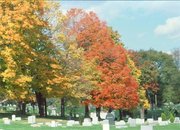Sugar Maple
|
|
| Sugar Maple Conservation status: Secure | ||||||||||||||
|---|---|---|---|---|---|---|---|---|---|---|---|---|---|---|
| Missing image SugarMaple.jpg A farm with a Sugar Maple in the front yard | ||||||||||||||
| Scientific classification | ||||||||||||||
|
The Sugar Maple Acer saccharum is a prominent tree in the hardwood forests of eastern North America. It is the largest American maple, reaching heights of 30-37 m tall.
The leaves are deciduous, 8-15 cm long and equally wide with five palmate lobes. The basal lobes are relative small, while the upper lobes are larger and deeply notched. In contrast with the angular notching of the Silver Maple, however, the notches tend to be rounded at their interior. The fall color is often spectacular, ranging from bright yellow through orange to fluorescent red-orange.
The flowers are in corymbs of 5-10 together, yellow-green and without petals; flowering occurs in early spring after 30-55 growing degree days. The fruit is a double samara with two winged seeds, the seeds are globose, 7-10 mm diameter, the wing 2-3 cm long.
This tree is closely related to the Black Maple which is sometimes included in this species but sometimes separated as Acer nigrum.
Cultivation and uses
Sugar Maple, and also Black Maple, are superb sources of sap for making maple syrup, with the Black Maple being regarded as being slightly the better. Almost all maples can be used as a sap source for maple syrup, but none of the others are as good as these two.
The wood is one of the hardest of the maples, and is prized for furniture and flooring. Bowling alleys and bowling pins are both commonly manufactured from sugar maple. A special type of maple, "birdseye maple" with wavy grain, is especially valued.
The Sugar Maple is a favorite street and garden tree, because it is easy to propagate and transplant, is fairly fast-growing, and has beautiful fall color. It also has some of the most dense shade to be found in shade trees. The shade and the shallow, fibrous roots may interfere with grass growing under the trees.
Cultivars of Sugar Maple include the tough-leaved 'Legacy' and 'Green Mountain', pyramidal 'Arrowhead', fast-growing 'Bonfire' and cutleaf 'Sweet Shadow'. 'Norselect' and 'Unity' are hardy selections suitable for the Prairie Provinces of Canada as far north as Edmonton, Alberta. Columnar varieties includee 'Columnare', 'Monumentale', 'Temple's Upright' and the very narrow 'Newton Sentry'.
Sugar Maple is the State Tree of New York, Vermont, West Virginia and Wisconsin.
See also
References
- Godman, Yawney and Tubbs. Sugar Maple (http://www.na.fs.fed.us/spfo/pubs/silvics_manual/volume_2/acer/saccharum.htm)
- Acer saccharum (http://www.hcs.ohio-state.edu/hcs/TMI/Plantlist/ac_harum.html)
- Columnar Trees for the Landscape (http://www.agnr.umd.edu/users/ipmnet/99-3nnws2.htm)de:Zucker-Ahorn


